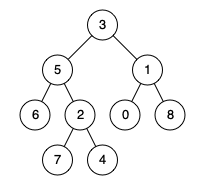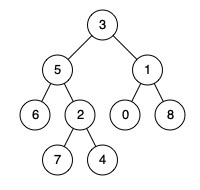给定一个二叉树, 找到该树中两个指定节点的最近公共祖先。
百度百科中最近公共祖先的定义为:“对于有根树 T 的两个节点 p、q,最近公共祖先表示为一个节点 x,满足 x 是 p、q 的祖先且 x 的深度尽可能大(一个节点也可以是它自己的祖先)。”
示例 1:
输入:root = [3,5,1,6,2,0,8,null,null,7,4], p = 5, q = 1
输出:3
解释:节点 5 和节点 1 的最近公共祖先是节点 3 。
示例 2:
输入:root = [3,5,1,6,2,0,8,null,null,7,4], p = 5, q = 4
输出:5
解释:节点 5 和节点 4 的最近公共祖先是节点 5 。因为根据定义最近公共祖先节点可以为节点本身。
示例 3:
输入:root = [1,2], p = 1, q = 2
输出:1
提示:
树中节点数目在范围 [2, 105] 内。
-109 <= Node.val <= 109
所有 Node.val 互不相同 。
p != q
p 和 q 均存在于给定的二叉树中。
class Solution {/**我们可以使用递归来处理,递归终止条件是我们当前root等于p或者等于q或者等于null就返回root,然后递归处理左节点和右节点,当左节点为空时,我们就返回右节点(包括右节点不空和空的情况),因为左节点为空说明p,q都在右节点上,右节点同理如果都不为空,则返回root(说明当前节点为左右公共父节点)*/public TreeNode lowestCommonAncestor(TreeNode root, TreeNode p, TreeNode q) {if(root == null || root == p || root == q) return root;TreeNode left = lowestCommonAncestor(root.left,p,q);TreeNode right = lowestCommonAncestor(root.right,p,q);if(left == null) return right;if(right == null) return left;return root;}}

